The men’s 110 meter high hurdles over the 42-inch barriers is the only hurdle event in track in which it can unequivocally be said that technique matters more than speed. Over the 39-inch hurdles at the high school level, a hurdler with superior speed can get away with a lot of flaws and beat a better technician. The same obviously holds true for the girl’s/women’s 100 meter hurdles from the ninth grade all the way to the international level. In the 300m/400m hurdle events, the same holds true. A technician can’t beat a stud quarter-miler. There’s too much room to sprint between the hurdles and not enough hurdles in the way to slow down all that speed. But in the 110s over 42s, the hurdles are too high for a pure sprinter to succeed. Technique is a must. As is the relevant strength, flexibility, and stamina that the event demands.
Generally speaking, Americans approach the 110s as a sprint event, not a technical event. The race is often referred as the “sprint hurdles,” and coaches often say that the 110 race is a sprint race with hurdles in the way. Maybe that approach is all wrong. Maybe that ideology is impractical. Maybe favoring speed over technique is ineffective. Maybe that’s why, even though America still has plenty of top-notch hurdlers and had seven of the top ten hurdlers in the world in 2007, neither of the two top-ranked hurdlers in the world in 2007 – Liu Xiang and Dayron Robles – were Americans.
When we’re talking about the art of hurdling, the men’s 110s is the event we’re referring to, because that’s the only event that absolutely requires technical mastery of its athletes. And what would’ve been considered mastery ten years ago isn’t mastery anymore. That which used to be cutting edge becomes old-school pretty quickly. The event evolves.
Let’s take a look at some of the innovators that have pushed the event forward since the early 1970s:
Rodney Milburn: The 1972 Olympic champion transformed the event from “three steps and a jump” into an actual sprint race in which you try to actually run through the hurdle, not jump over the hurdle. He also invented the double-armed lead – a way to gain power over the hurdle and reduce airtime.
Renaldo Nehemiah: The three-time world-record-holder brought in the importance of lead-leg snapdown as a key to sprinting through hurdles, minimizing the loss of velocity. The ideal with Nehemiah was to make the hurdle motion as close to the actual sprinting motion as possible.
Greg Foster, Roger Kingdom: Foster, the three-time world champion, and Kingdom, the two-time Olympic champion, were both great hurdlers, but they were not innovators in the sense that Milburn and Nehemiah were. Kingdom was sort of a bigger, stronger version of Milburn. Foster’s technique improved every year, but he didn’t take the event beyond where Nehemiah had put it.
Colin Jackson, Allen Johnson: These two dominant hurdlers of the 1990s (and into the new millenium for Johnson) were also among the greatest ever, but both were more or less descendants of Nehemiah in terms of style. Johnson had (has) a better trail leg, but would always hit a lot of hurdles. Like Nehemiah, he had trouble fitting his speed in between the hurdles. I would say though, that the Johnson who won the 2006 World Cup in 12.96 was a technical master. Same goes for the Jackson who won the 1993 World Championship in 12.91.
Liu Xiang: The 2004 Olympic champion and current world record holder is the next great hurdling innovator. I would say that he is the first true innovator since Nehemiah. More so than any other hurdler in history, Xiang is a masterful technician. Watching him hurdle conjures up images of Tae Kwon Do masters or Karate experts. Xiang has made hurdling into a martial art. It seems that, in terms of technical efficiency, Xiang, as well as Cuban star Dayron Robles, have surpassed the crop of current Americans.
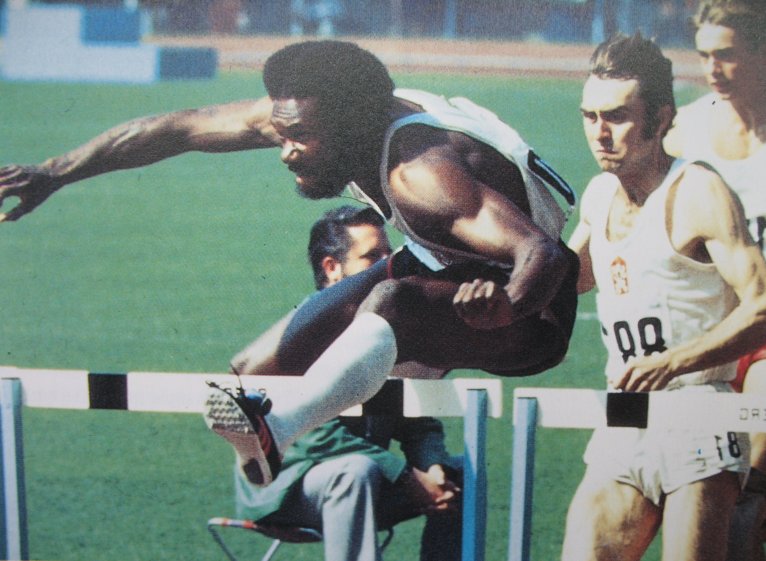
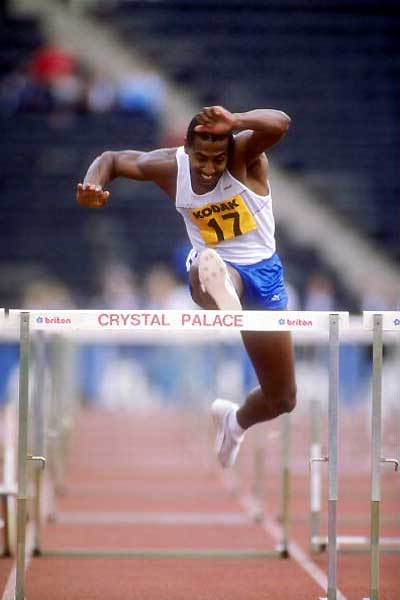
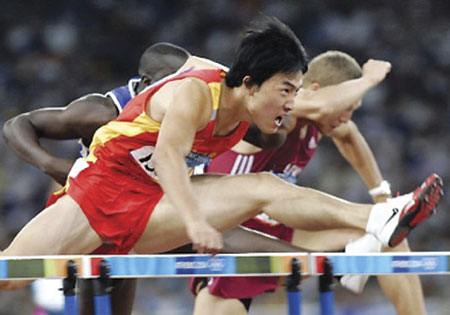
Milburn, Nehemiah, and Xiang are the three major innovators in the high hurdles over the past 40 years.
Could it be that American hurdlers have relied upon speed and strength for too long, and that now their lack of focus on making technical improvements has caught up to them? Let’s look at this question a little more closely. Because, as one of my athletes has pointed out to me, if those guys are running that fast (under 13.20), they must running that fast for a reason.
First off, let’s note that all hurdlers at the elite level are doing certain things right regardless of any technical flaws they may have. First and foremost, in the tradition of Nehemiah, Milburn, Foster, and others from bygone eras, they all have lightning-quick lead legs. We’re not just talking about the obvious hurdlers like Allen Johnson, Dominique Arnold, and Terrence Trammell. But also the next tier of elite Americans – David Payne, David Oliver, Aries Merritt, Ryan Wilson, Anwar Moore– all have quick lead legs. Secondly, all the abovementioned hurdlers have very low hurdle clearance. None of them have any extra space over the crossbar. The calf and hamstring of their lead leg skim the barriers.
With the exception of Allen Johnson, the biggest problem that American hurdlers have, especially in comparison to Xiang and Robles, lies in the trail leg. Some American hurdlers almost literally run sideways down the track, because their trail leg never catches up to their lead leg. Roger Kingdom back in the day was probably the worst for this, but Trammell and Payne are two modern hurdlers who, to a lesser degree, also have this problem. Their lead legs are super-fast, they have very low hurdle clearance, they have a very quick three-step shuffle between the hurdles, and they have tremendous sprint speed – all of which compensates for their comparatively slow trail legs. Hurdlers with great sprinting speed can get away without a properly-functioning trail leg. But there is a price to pay – their hips are always twisting on top of the hurdle, costing them precious time. So when it comes to competing against the likes of a Xiang or a Robles, those trail leg issues can be killers. With Xiang in particular, you will never see a twist in the hips. He is a hurdler who basically has no balance issues, especially in the latter half of races, when he generally takes over.
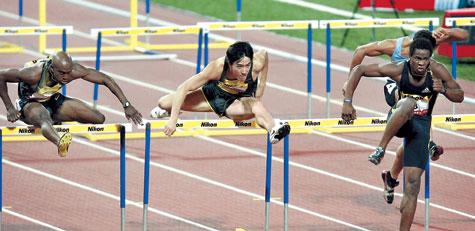
Allen Johnson is the only American whose technical mastery equals that of Xiang and Robles.
The race that clearly demonstrates what I’m talking about is the Reebok meet in New York in 2007, when Xiang defeated Trammell – 12.92-12.95 – although Trammell blasted Xiang out of the blocks and led for most of the race. If you look at that race closely, you’ll notice that, even early in the race, when Trammell is way ahead, he is hitting hurdles with his trail leg, that his trail leg is lagging behind his lead leg, that his hips are slightly twisting as his lead leg snaps down off of every hurdle. Gradually, Xiang, whose trail leg is just as quick and explosive as his lead leg, has no twist in the hips, so he is gradually able to make up ground on Trammell. Not because he is running faster, but because he is not losing velocity on top of hurdles like Trammell is. So I’m sure you’re asking, How can someone snapping down as fast as Trammell lose ground over the hurdles? The answer lies in the trail leg. If your trail leg is late, and your hips are twisting, and you have to realign yourself every time you land, you’re slowing down. Yes, the loss of velocity for someone of Trammell’s abilities is minimal, but Xiang obviously capitalized in that Reebok race, as well as in the ’07 World Championship final.
I also feel that American hurdlers largely underestimate the importance of the lead arm. Xiang’s lead arm is the key to his speed on top of hurdles. It speeds up everything else – the lead leg, the trail leg, the whole hurdling motion. Everything is trying to keep up with the lead arm. Not only does he not allow the arm to cross his body, but he whips it up and he whips it back down. It’s not a pretty motion, it’s not a fluid motion. It’s a violent motion. But, despite the violence, it’s not a wild motion. It’s a controlled violence, contained within a very tight framework of space. So if the arm is whipping up and down the way Xiang’s does, the rest of the body has no choice but to catch up, to whip up and down, or else he’d fall flat on his face. American hurdlers, for the most part, still use their lead arm for balance; they gain very little power and velocity off of it. Again, look at the Reebok race, where Xiang and Trammell are side-by-side, and take a look at difference between their lead arms.
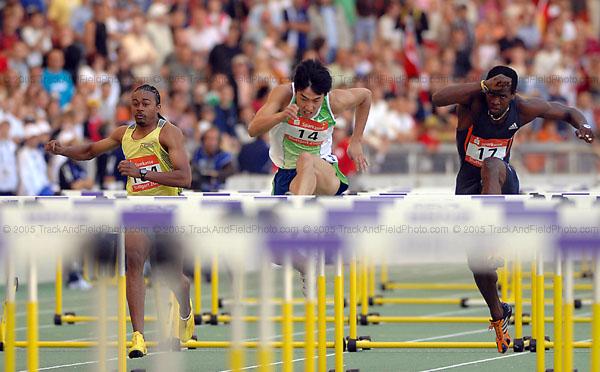
Xiang and Robles both have very efficient arm action. This photo shows that Xiang’s is tighter, as he keeps his elbows close to his body, creating more of an up-and-down motion, minimizing lateral movement. Merritt, on the left, is already beginning his arm motion before his third step even touches down. Because Merritt’s lead arm swings outward and upward as he attacks the hurdle, he generates a lot of speed and power with it. The downside, though, is that the motion takes a long time to execute.
It amuses me, or should I say it annoys me, when I hear people say that there’s no way Xiang should be beating all these Americans who are better athletes with stronger bodies and faster flat sprinting speed. How does that skinny Chinese guy with no ab muscles and rail-thin arms keep beating the Americans? The answer is simple: technique. Xiang is a master of technique.
Let me back-track a little bit before I go forward again: When I first started coaching in the mid-‘90s, I realized pretty quickly that, at the high school level, if I could get kids to three-step and lead with the knee, I could make them pretty competitive. After that, it’s just a matter of refining things and smoothing things out. Most coaches, it seemed, neither knew nor cared about hurdling technique. I always felt like my kids could out-technique the hurdlers from other schools, even if the kids from other schools were faster. “Make ‘im make a mistake,” is what I’d always tell my hurdlers when they were up against a tough opponent. And, usually, if you can keep the race close and can remain technically sound for ten hurdles, you can count on the fact that someone a little bit faster or stronger will eventually make a mistake that you can capitalize on.
Really, I think that’s the approach Xiang takes when competing against the Americans – be technically sound for ten hurdles and capitalize on their mistakes. Check out this quote from Xiang’s coach, Sun Haiping:
“It’s true that physically it is easier to think about a Chinese athlete as a distance runner. If you compare the Americans and some Europeans there is no match, they are physically more skilled and much stronger than we are. But I think that Chinese can be technically better and are keener to work hard. That is how we will close the gap.”
Ouch. If that’s not a slap in the face, I don’t know what is. Haiping is basically saying that the Americans are too lazy to put in the work necessary to develop technical mastery. I’m sure he didn’t mean it that way, but that’s what I got out of it. Xiang himself has said, “My physique is poor, but through extra-hard training, I can make up for my deficiencies.” To Xiang, technique is the great equalizer. Because hurdling is technical, and not just athletic, the “lesser” athlete can be competitive. In explaining why he got involved in hurdling in the first place, he said, “I liked the fact that so much of hurdles is about technique and that you have to approach the sport very scientifically. For some reason, the sport felt very Chinese to me, even though Chinese have not been so successful in it.”
Indeed, the Chinese are masters of the martial arts, which, like the hurdles, require quick, forceful movements that put the body in difficult positions that necessitate exceptional flexibility, control, and mental focus. After winning the gold medal at the 2004 Olympics in what was then a world-record-tying 12.91, Xiang commented that, “Given the Asian physiology, few expected that a Chinese would ever be able to run under 13 seconds.” In explaining how he did it, he said, “I just wanted to perform at my best and raise my technique to the best level.”
After Xiang brought the world record down to 12.88 in July of 2006, former world-record-holder and current agent Renaldo Nehemiah made the following observation: “Xiang’s body is phenomenally flexible. You have to be able to react to the hurdle. And as I understand he has a good gymnastic base to his fitness.”
Nehemiah also noted that Xiang actually benefits from the fact that he is not as fast as other hurdlers. “He can race the hurdles at his top speed without fear of going too fast,” Nehemiah said. “He is able to relax, not worrying about going too fast, and can just concentrate on his technique, clearing the hurdles low. His opponents are much quicker flat sprinters but that speed is a disadvantage for them. For example Terrence Trammell is a much faster sprinter but he never gets to use that extra speed to his advantage while hurdling.”
I agree, in part, with Nehemiah’s assessment. The part I don’t agree with is the idea that Xiang can run at top speed without fear of going too fast. Even a high school kid running in the 14-mid range over 39s cannot use all of his speed between the hurdles. What I think is true, in the case of Xiang, is that his technical proficiency allows him to use more of his flat speed than other hurdlers.
Right now, if I’m an American hurdler, I’m studying Liu Xiang. I’m watching films of his races and trying to figure out what he’s doing that I’m not. Not just so I can beat him, but so that I can further my mastery of the art form. Xiang’s hurdling mechanics need to be scrutinized thoroughly on an intellectual, analytical level. The American hurdler who can combine athleticism with technical mastery is the one who will take the event to the next level, beyond Xiang.
© 2008 Steve McGill
Here’s a link to the 2007 Reebok Invitational 110 hurdle race on youtube.
